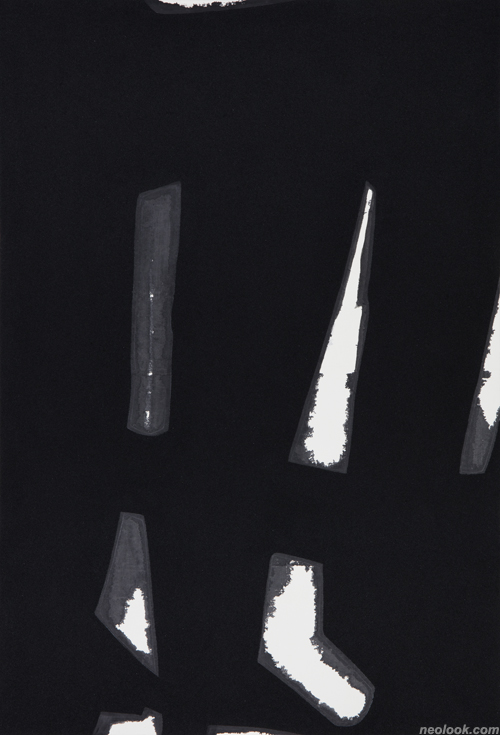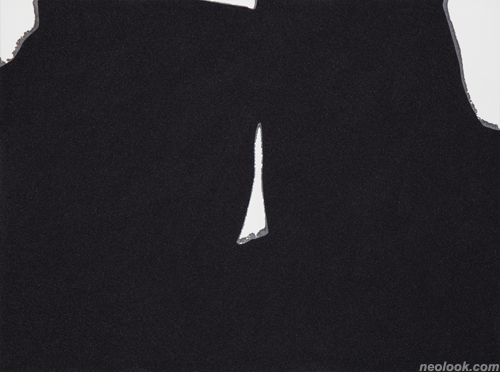- ● homepage
- ● archives
- ● restoration
- ● books
- ● big banners
- ● post board
- ■ neo's search
- ■ about us
- ■ 게재방법 안내
- 개인정보처리방침

- [email protected]
- Tel. 02_335_7922
- Fax. 02_335_7929
- 10:00am~04:30pm
- 월요일~금요일
- 3/3(월) 대체공휴일

소리 없이 시를 읊다 黙吟, Poetry with Silence
김정환展 / KIMJEONGHWAN / 金政煥 / painting 2017_1014 ▶ 2017_1020
● 위 이미지를 클릭하면 네오룩 아카이브 Vol.20160904h | 김정환展으로 갑니다.
초대일시 / 2017_1014_토요일_05:00pm
관람시간 / 10:00am~07:00pm
갤러리 지오 GALLERY GO 인천시 중구 신포로15번길 69(해안동2가 8-15번지) Tel. +82.(0)32.773.8155 gallerygo.co.kr
自序 시끄러운 세상이다. 저마다의 목소리를 내다보니 세상이 온갖 소리로 떠들썩하다. 역설적으로 침묵의 소중함을 느끼게 된다. 침묵을 시각적으로 드러내는 것은 쉽지 않은 일이다. 침묵을 하나의 시어(詩語)처럼 간결하게 표현하고 싶었다. 이미지를 통해 드러내고자 했던 것은 마음 속의 메아리와 울림이기도 하고, 나만의 시선(視線)이기도 하다. 작업하는 내내 스스로를 비춰 볼 수 있었다. 검은색을 통해 침묵의 심연에 다가서는 여정이었다. (2017년 10월)

- 김정환_묵음(黙吟_Poetry with Silence)17-09-02_ 캔버스에 붙인 한지에 먹, 규사_97×145.5cm_2017

- 김정환_묵음(黙吟_Poetry with Silence)17-03-11_ 캔버스에 붙인 한지에 먹, 규사_130.5×89.5cm_2017

- 김정환_묵음(黙吟_Poetry with Silence)17-02-12_ 캔버스에 붙인 한지에 먹, 규사_117×91cm_2017
'김정환 - 그리고 쓰고 새긴 듯한, 검은 그림' ● 김정환의 그림은 검정색의 물질이 점유하고 있는 부분과 나머지 부분, 이른바 여백으로 이루어진 단순한 구성으로 이루어졌다. 종이위에 칠해진 영역과 칠해지지 않고 의도적으로, 우연적으로 불가피하게 남겨진 영역으로 형성된 이 미니멀 한 화면은 주어진 사각형의 평면을 다양하게 절개하고 있다. 무엇인가를 표현하고 재현하기 보다는 공간을 분할하고 나누고 의미 있는 구성으로 응고시켰다는 인상이다. 순간 칠한 부분과 남겨진 부분, 의미를 부여한 공간과 나머지 부분, 보여주는 부분(가시적 영역)과 의도적으로 은폐한, 억압한(비가시적 영역) 부분간의 상호작용, 길항관계가 이루어진다. 포지티브와 네거티브 한 공간, 음양의 공간 대비가 흥미롭다. 또한 그것은 쓰기와 그리기, 문자와 그림의 경계를 의도적으로 지우거나 그러한 구분을 무의미하게 만드는 원초적인 흔적과도 같다. 왜냐하면 이 그림은 그린 것인지 쓴 것인지, 회화적으로 칠을 한 것인지 아니면 저부조(조각)로 물질을 마감한 것인지 애매한 느낌을 준다. 화면의 상당부분을 시커멓게 덮고 있는 검은 물질(검정색)은 거대한 흐름, 기운, 운동의 경로 같기도 하고 특정 형상을 남기려는 시도 같기도 하고 문자의 부분 같다는 인상을 준다. 동시에 그 어느 것으로도 확정되지 않고 미끄러진다. 무엇보다도 이 그림에서는 칠해지고 남겨진 부분, 화면을 채운 검은색의 물성이 주는 힘과 그 색채의 의미, 그리고 그 모든 것을 오로지 단 하나의 색, 흑백의 구성만으로 전달하는 압축과 절제의 미학 같은 것들이 숨을 쉬고 있다.

- 김정환_묵음(黙吟_Poetry with Silence)17-09-10_ 캔버스에 붙인 한지에 먹, 규사_112×162cm_2017

- 김정환_묵음(黙吟_Poetry with Silence)17-08-14_ 캔버스에 붙인 한지에 먹, 규사_80.5×117cm_2017

- 김정환_묵음(黙吟_Poetry with Silence)17-07-02_ 캔버스에 붙인 한지에 먹, 규사_100×80.5cm_2017
김정환의 화면은 마치 전각의 작은 사각형 안에서 구현되는 방촌의 미학이나 서예에서 엿볼 수 있는 검은색과 여백의 미감을 연상시킨다. 그것은 작가의 다양한 이력에서 연유하는 측면도 있어 보인다. 그는 어린 시절부터 서예를 했고 이후 서예작가를 위시해 전각 및 서예평론, 회화작업 등으로 영역을 넓혀온 이다. 현재 그는 서예와 전각을 기본으로 하고 이를 바탕으로 한 추상회화를 시도하고 있다. 여기에는 단지 서예와 전각을 응용한 특정한 조형행위에 머물지 않고 그 저간에 자리한 특유의 조형론, 동양의 예술론 등에서 길어 올린 문제의식을 대상화하면서 작업을 전개하고 있다는 인상이다. 작가는 무엇보다도 검은 색에 의미를 부여하고 '검을 현'이 지닌 여러 뜻, 그 문자가 거느리고 있는 언어적 의미망을 반추시킨다. 여기에는 무엇보다도 수묵의 미학이 중심축일 것이다. 동시에 동양화론에서 중요하게 거론되는 언어와 회화의 관계(문자와 그림, 시와 언어) 또한 중요해 보인다. 동양문화권에서, 동양화에서 그림과 문자는 분리되지 않는다. 그러나 근대 이후 문자와 그림은 별개의 세계로 나뉘었다. 이번 근작의 제목은 「묵음(黙吟)」이다. 묵음이란 '소리 없이 시를 읊다'라는 뜻이다. 그의 그림은 문자의 자취를, 시의 자리를 이미지화시킨다. 이미지와 문자는 상호보조적인 관계를 형성하면서 서로 부족한 부분을 채워나간다. 옛 그림을 보면 이미지와 문자는 항시 화면 안에 공존하고 길항했다. 우리가 접하고 경험하고 추억하는 세계는 이미지만으로, 문자만으로 자립하기 어려운 세계다. 김정환은 흑백의 단순한 구성을 통해 마치 그리듯이, 쓰듯이, 새기듯이 무엇인가를 흔적화 했다. 그것은 문자의 어느 한 부분을, 전각의 어느 한 파편을, 그림의 어느 한 부위를 추측케 한다. 상상하게 한다. ■ 박영택

- 김정환_묵음(黙吟_Poetry with Silence)17-08-21_ 캔버스에 붙인 한지에 먹, 규사_97×130cm_2017

- 김정환_묵음(黙吟_Poetry with Silence)17-03-19_ 캔버스에 붙인 한지에 먹, 규사_100×80.5cm_2017

- 김정환_묵음(黙吟_Poetry with Silence)17-05-05_ 캔버스에 붙인 한지에 먹, 규사_116.5×91cm_2017
Artist's preface The world is now noisy. It is full of noises as everyone raises their voice. I feel, paradoxically, the importance of silence. It is challenging to express silence in a visual way. I want to express silence concisely like a single poetic word. What I attempt to reveal through images is echoes and sounds in my heart and my own perspective as well. I could have projected myself throughout my work. It was a journey to abyss through the color of black. (October 2017) ■ Kim Jeonghwan
Jeonghwan Kim's paintings are simple; they consist of parts taken up by black material and the rest – what could be referred to as blank space. Such minimalist composition, made up of painted area and the rest of paper which is deliberately, coincidentally and inevitably left unpainted, divides the quadratic surface into various pieces. The works don't seem to express or represent anything in particular; rather, they seem to be focused on dividing space and creating meaningful composition. Painted area and the rest; area imbued with meaning and the rest; area shown (visible) and area deliberately concealed and suppressed (invisible) – these spaces interact and compete with one another. ● Of particular interest is the contrast between positive and negative space – between the areas of yin and yang. The boundaries between writing, painting, letters and picture are deliberately eliminated or rendered futile in what is the mark of the origin. There is a thick layer of ambiguity; is it a work of painting, coloured like painting, or sculpted with material? The dark material (black) which covers a significant area of the work seems like a grand movement of energy and flow; or is it an attempt at an expression of some form, or a part of a letter? There is no fixed formation; only smoothing over. Above all, the painting exudes an aesthetics of compression and restraint, delivered only though blank, unpainted space, power and significance of black material filling the surface, and the simple monochrome composition which embraces it all. ● Jeonghwan Kim's paintings allude to the aesthetics of thumb-sized seal engraving, or to the black-white contrast seen in traditional calligraphy. Some of it is no doubt from the artist's diverse experiences. Kim, from an early age, has practiced calligraphy, later expanding to seal engraving, calligraphic criticism and painting. Currently, Kim practices calligraphy and seal engraving upon which he bases his abstract painting. Of course, this is no mere application of calligraphy and seal engraving; what is instead found is a unique formative perspective which embodies an Asian aesthetic theory and awareness of artistic issues at hand. The artist imbues 'black' with significance and ruminates various meanings of hyun (black) – its linguistic significance network. Here, the aesthetics of ink forms the central axis. Also significant is the relationship between language and painting (letters and painting, poetry and language) which is deemed important in Asian painting theories. In Oriental culture, especially in Oriental painting, letters and pictures are not separated. ● However, in modern age, letters and paintings have been divided into separate worlds. The title of Kim's latest work is Muk-eum, which means 'silent reading of poetry.' His paintings make images out of the marks of letters, of the place of poetry. Image and writing form an interactive relationship and complement each other. In old paintings, image and letter always coexisted in the same frame. The world we encounter, experience and reminisce cannot stand with letters or image alone. Jeonghwan Kim's simple black-and-white composition makes a mark of that something, as if painting, writing or engraving. This makes the viewer suspect – indeed imagine – a part of letter, a segment of a seal, or a part of a painting. ■ Youngtaek Park
Vol.20171014e | 김정환展 / KIMJEONGHWAN / 金政煥 / painting

